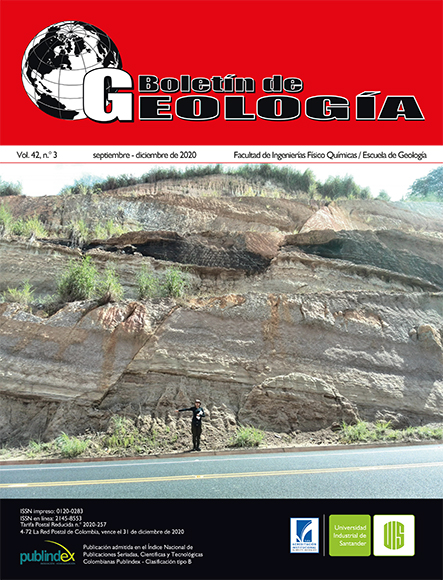General considerations for the development of the Peruvian atlas of CO2 geological storage
Published 2020-09-30
Keywords
- CO2 sequestration,
- CO2 geological stores,
- Geological formations for storage,
- Atlas of CO2 storage in Peru
How to Cite
Copyright (c) 2020 Boletín de Geología

This work is licensed under a Creative Commons Attribution 4.0 International License.
Altmetrics
Abstract
CO2 capture and sequestration or geological storage is the best alternative for reducing excess anthropogenic CO2 emissions into the environment, both for technical and economic considerations. The volumes of CO2 and the prolonged residence times in the geological deposits make it especially interesting. Although it has not been tested on a large scale, the different pilot projects carried out and those underway in various parts of the world have shown very encouraging results.
This work develops the most important principles to be taken into account when preparing a geological atlas for storage of CO2. The theoretical-practical foundations for the geological sequestration of CO2 are reviewed, the types and mechanisms of carbon dioxide sequestration in the different geological formations are also developed, then is reviewed the main criteria for the selection of sites and the indicators of suitability for the sequestration of carbon dioxide. It presents a system of classification of sites according to the geological knowledge of the selected formation, which is an adaptation of geological experience in oil and gas exploration. It tentatively proposes geographical areas to investigate and collect geological information based on existing potential storage sites and it also exposes a methodology for estimating the storage capacity for geological sequestration of carbon dioxide depending on the formations that could be found.
Downloads
References
Bachu, S.; Bonijoly, D.; Bradshaw, J.; Burruss, R.; Holloway, S.; Christensen, N.P.; Mathiassen, O.M. (2007). CO2 storage capacity estimation: Methodology and gaps. International Journal of Greenhouse Gas Control, 1(4), 430-443. https://doi.org/10.1016/S1750-5836(07)00086-2
Beltrán, L.; Dávila, M.; Contreras, C.; Arévalo, V.; Valenzuela, J.M.; Jiménez, O.; Medina, E. (2012). Atlas de Almacenamiento Geológico de CO2. Secretaria de Energía, Comisión Federal de Electricidad, México.
Bradshaw, B.E.; Spencer, L.K.; Lahtinen, A.L.; Khider, K.; Ryan, D.J.; Colwell, J.B.; Chirinos, A.; Bradshaw, J.; Draper, J.; Hodgkinson, J.; McKillop, M. (2011). An assessment of Queensland’s CO2 geological storage prospectivity—The Queensland CO2 Geological Storage Atlas. Energy Procedia, 4, 4583-4590. https://doi.org/10.1016/j.egypro.2011.02.417
Burruss, R.C.; Brennan, S.T.; Freeman, P.A.; Merrill, M.D.; Ruppert, L.F.; Becker, M.F.; Herkelrath, W.N.; Kharaka, Y.K.; Neuzil, C.E.; Swanson, S.M.; Cook, T.A.; Klett, T.R.; Nelson, P.H.; Schenk, C.J. (2009). Development of a probabilistic assessment methodology for evaluation of carbon dioxide storage. U.S. Geological Survey Open-File Report 2009-1035.
Calhoun, Jr., J.C. (1982). Fundamentals of reservoir engineering. Norman: University of Oklahoma Press.
Chadwick, A.; Arts, R.; Bernstone, C.; May, F.; Thibeau, S.; Zweigel, P. (2008). Best practice for the storage of CO2 in saline aquifers - observations and guidelines from the SACS and CO2STORE projects. British Geological Survey.
ChemicaLogic Corporation (1999). Carbon Dioxide: Temperature - Pressure Diagram.
CO2CRC. (2012). The cooperative research centre for greenhouse gas technologies. What-is_CCS? CO2CRC. Consultado el 18 de octubre de 2018. http://www.co2crc.com.au/
Dirección General de Electricidad. (2016). Anuario ejecutivo de electricidad 2016. Ministerio de Energía y Minas, Lima, Perú.
DOE - Laboratory, U.D. (2010). Carbon sequestration Atlas of the United States and Canada. U.S. Department of Energy’s (DOE).
DOE & NETL. (2015). Carbon Storage Atlas. (5th ed.). Department of Energy’s (DOE) National Energy Technology Laboratory (NETL). http://www.netl.doe.gov/
Frailey S.M.; Finley R.J. (2009). Classification of CO2 Geologic Storage: Resource and Capacity. Energy Procedia, 1(1), 2623-2630. https://doi.org/10.1016/j.egypro.2009.02.029
Goodman, A.; Hakala, A.; Bromhal, G.; Deel, D.; Rodosta, T.; Frailey, S.; Small, M.; Allen, D.; Romanov, V.; Fazio, J.; Huerta, N.; McIntyre, D.; Kutchko, B.; Guthrie, G. (2011). U.S. DOE methodology for the development of geologic storage potential for carbon dioxide at the national and regional scale. International Journal of Greenhouse Gas Control, 5(4), 952-965. https://doi.org/10.1016/j.ijggc.2011.03.010
INGEMMET (2020). Mapa Geológico del Perú. INGEMMET, Perú.
Leung, D.Y.; Caramanna, G.; Maroto-Valer, M.M. (2014). An overview of current status of carbon dioxide capture and storage technologies. Renewable and Sustainable Energy Reviews, 39, 426-443. https://doi.org/10.1016/j.rser.2014.07.093
Medina-Ketzer, J.M.; Machado, C.X.; Rockett, G.C.; Iglesias, R.S. (2016). Atlas Brasileiro de Captura e Armazenamento Geológico de CO2. Universitária da PUCRS.
MINEM (2017). Plan de desarrollo de los recursos de hidrocarburos 2017 - 2021. Ministerio de Energía y Minas.
Naciones Unidas UNFCC (2015). Aprobación del Acuerdo de Paris.
Norwegian Petroleum Directorate. (2014). CO₂ Storage Atlas: Norwegian Continental Shelf. https://www.npd.no/en/facts/publications/co2-atlases/co2-atlas-for-the-norwegian-continental-shelf/
OIT (1989). Convenio (N. 169) sobre pueblos indígenas y tribales en países independientes.
C169. Organización Internacional del Trabajo.
PNUMA. (2005). La captación y el almacenamiento de dióxido de carbono. Grupo Intergubernamental de Expertos sobre el Cambio Climático.
Society of Petroleum Engineers. (2018). Sistema de Gerencia de los Recursos de Petróleo. Ed. Society of Petroleum Engineers and the Oil and Gas Reserves.
Van der Meer, L.G.H.; Yavuz, F. (2009). CO2 storage capacity calculations for the Dutch subsurface. Energy Procedia, 1(1), 2615-2622. https://doi.org/10.1016/j.egypro.2009.02.028

